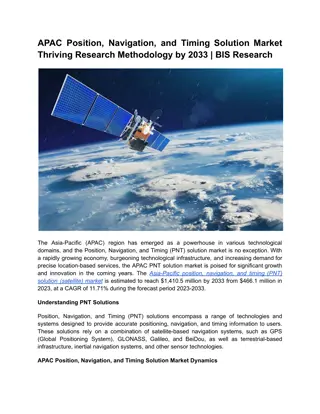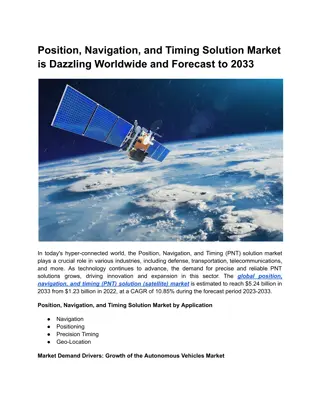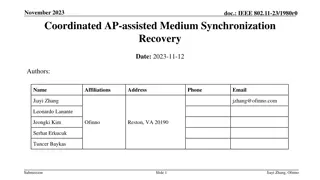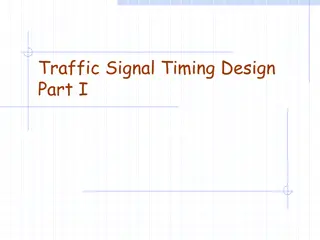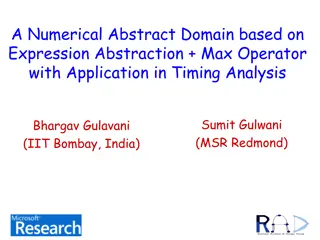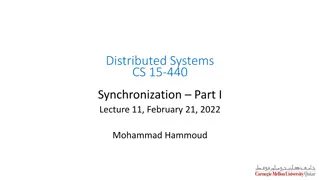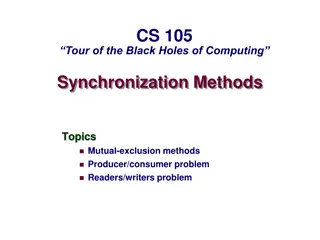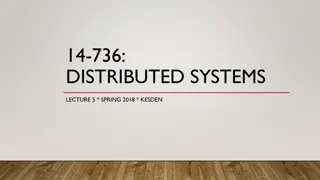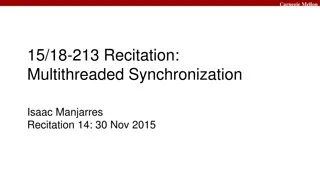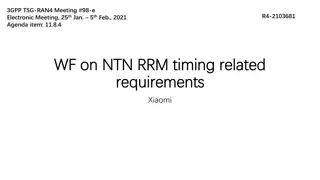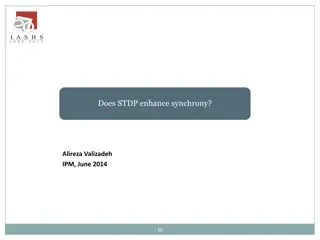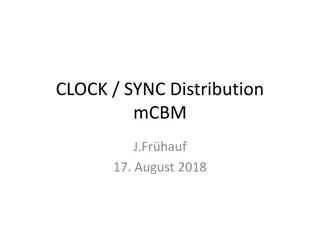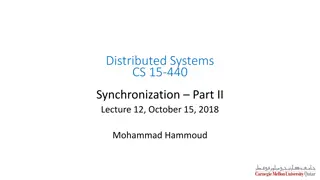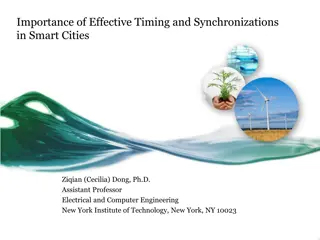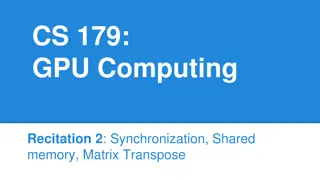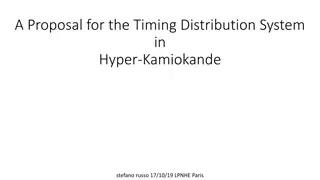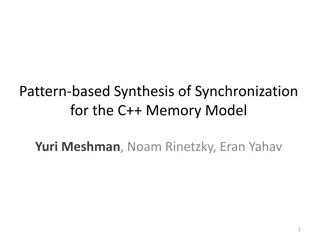APAC Position, Navigation, and Timing Solution Market Analysis & Forecast
The Asia-Pacific position, navigation, and timing (PNT) solution (satellite) market is estimated to reach $1,410.5 million by 2033 from $466.1 million in 2023, at a CAGR of 11.71% during the forecast period 2023-2033.\nRead Report Overview: \/\/bisresearch.com\/industry-report\/asia-pacific-position
11 views • 3 slides
Position, Navigation, and Timing Solution Market Forecast to 2033
The global position, navigation, and timing (PNT) solution (satellite) market is estimated to reach $5.24 billion in 2033 from $1.23 billion in 2022, at a CAGR of 10.85% during the forecast period 2023-2033.\nRead Report Overview: \/\/bisresearch.com\/industry-report\/position-navigation-timing-solu
0 views • 3 slides
Machine Learning for Predicting Path-Based Slack in Timing Analysis
Utilizing machine learning to forecast path-based slack in graph-based timing analysis offers a solution for optimizing power and area efficiency in the design process. The Static Timing Analysis incorporates accurate path-based analysis (PBA) and fast graph-based analysis (GBA) to estimate transiti
1 views • 31 slides
IEEE 802.11-23/1980r1 Coordinated AP-assisted Medium Synchronization Recovery
This document from December 2023 discusses medium synchronization recovery leveraging multi-AP coordination for multi-link devices. It covers features such as Multi-link device (MLD), Multi-link operation (MLO), and Ultra High Reliability (UHR) capability defined in P802.11bn for improvements in rat
0 views • 8 slides
Coordinated AP-Assisted Medium Synchronization Recovery in IEEE 802.11-23/1980r0
This document discusses the proposal for medium synchronization recovery leveraging multi-AP coordination for multi-link devices in IEEE 802.11be EHT networks. It introduces the concept of AP-assisted medium synchronization recovery to assist non-AP STAs in transmitting frames without causing collis
0 views • 7 slides
Designing a Traffic Signal Timing Plan: Steps and Guidelines
This comprehensive guide covers the essential steps involved in designing a traffic signal timing plan, including determining lane configurations, proposing phase plans, identifying critical volumes, recommending phase plans, and establishing clearance intervals. It also provides insights into aspec
1 views • 26 slides
Preventing Active Timing Attacks in Low-Latency Anonymous Communication
This research addresses the vulnerabilities of onion routing to timing attacks and proposes solutions to prevent active timing attacks, focusing on low-latency anonymous communication systems. Various problems related to timing attacks in onion routing are analyzed, including the role of adversaries
0 views • 52 slides
Understanding Multi-Device Synchronization in JESD204B Data Converters
Exploring the complexities of achieving multi-device synchronization with JESD204B high-speed data converters. This presentation discusses advantages, disadvantages, and key considerations such as deterministic latency and clock design. Learn about requirements, tools, and synchronization strategies
0 views • 45 slides
Numerical Abstract Domain with Max Operator in Timing Analysis
Explore a numerical abstract domain based on expression abstraction and the Max operator with applications in timing analysis. The challenges in timing analysis, such as disjunctive and non-linear bounds, are discussed along with simple examples illustrating these concepts. The difficulty of proving
0 views • 21 slides
Synchronization in Distributed Systems: Examples and Taxonomy
Understanding the need for synchronization in distributed systems is vital for ensuring correct operation. Examples such as vehicle tracking and file writing highlight the importance of entities coordinating and agreeing on events and resource access. A broad taxonomy of synchronization reasons is d
2 views • 31 slides
Harvesting and Postharvest Techniques for Quality Seed Production
Understand the importance of harvesting crops at the right timing to maximize seed quality. Learn about half-matured and full-matured stages, postharvest ripening, and indicators for precise timing. Discover the significance of counting days from flowering/pollination for determining harvest timing.
0 views • 24 slides
Understanding Synchronization Methods in Computing
Exploring synchronization methods like mutual exclusion, deadlock, starvation, and hardware mutex support in computing. Learn about critical sections, preventing race conditions, and the challenges of synchronization. Consider the Test and Set method, its benefits and drawbacks, and the importance o
0 views • 24 slides
Challenges of Time Synchronization in Distributed Systems
Distributed systems face challenges in synchronizing physical time due to varying network paths and clock drifts. While physical time synchronization is useful for tasks like file timestamps, it involves complexities such as estimating communication latency and improving time estimation algorithms l
0 views • 30 slides
IEEE802.15-14-0110-01-0mag MAC Timing Discussion Points for IEEE 802.15.4 Revision
Initial discussion document submitted by Benjamin A. Rolfe from Blind Creek Associates addressing MAC timing issues in the IEEE 802.15.4 standard revision. The document identifies potential problems, provides a list of questions for consideration, and outlines areas for improvement. It includes stat
0 views • 8 slides
DL Synchronization and TCI State Activation Discussion
Discussing DL synchronization including TCI state activation with scenarios for beam indication timing, unified TCI framework, and reducing handover delay for Rel-18 LTM. Different procedures for DL synchronization and TCI state activation are explored, highlighting the importance of understanding a
0 views • 7 slides
Efficient Support for Synchronization Without Invalidations
Addressing complex software issues like data races and inefficiencies in hardware synchronization, the DeNovoSync solution provides efficient support for arbitrary synchronization without writer-initiated invalidations. By introducing disciplined shared memory with structured synchronization and exp
0 views • 40 slides
Carnegie Mellon Multithreaded Synchronization Recitation
Explore Carnegie Mellon's recitation on multithreaded synchronization, debugging tools, shared memory synchronization, critical sections, and locking. Dive into the Echo Server Sequential Handling code examples, finding weaknesses using telnet, and advanced debugging techniques with curl and binary
0 views • 34 slides
Understanding Time, Clock Synchronization, and Atomic Clocks
Delve into the intricacies of time and clock synchronization, from the rotation of the Earth to atomic clock standards. Explore the importance of physical clock synchronization and the practical implications on technologies like GPS. Uncover the terminology and methodologies involved in achieving pr
0 views • 24 slides
Cesarean Delivery Timing Guidelines for Women with Prior Uterine Scars
Society for Maternal Fetal Medicine provides cesarean delivery timing recommendations for women with prior uterine scars. For those with a history of classical cesarean, the risk of uterine rupture guides the timing of repeat cesarean. Similarly, women with prior myomectomy should plan delivery betw
0 views • 10 slides
Understanding C++ Parallelization and Synchronization Techniques
Explore the challenges of race conditions in parallel programming, learn how to handle shared states in separate threads, and discover advanced synchronization methods in C++. Delve into features from C++11 to C++20, including atomic operations, synchronization primitives, and coordination types. Un
0 views • 48 slides
IEEE 802.11-18-1269-00-00az Clock Synchronization Investigation
In July 2018, a document was presented by Feng Jiang et al. from Intel Corporation focusing on clock synchronization between ISTA and RSTA in IEEE 802.11-18-1269-00-00az standard. The document delves into the impact of sampling clock errors on range estimation, carrier frequency synchronization in 1
0 views • 10 slides
Applications of RC Circuits in Electronics and Biomedical Devices
RC circuits play a crucial role in various applications such as camera flashes, timing devices in automobiles, and heart pacemakers. These circuits involve charging and discharging a capacitor through a resistor, controlling voltage pulses for precise timing. In devices like camera flashes, the flas
0 views • 7 slides
NTN RRM Timing Related Requirements for Xiaomi Devices at 3GPP TSG-RAN4 Meeting #98-e
The agenda item for the 3GPP TSG-RAN4 Meeting #98-e involves discussing NTN RRM timing related requirements, specifically focusing on UE timing synchronization for Xiaomi devices. Key aspects include UE transmit timing error limits, timing advance accuracy, and UE timer accuracy requirements for NTN
0 views • 6 slides
WylasTiming - Wireless Semi-Automatic Timing System Overview
WylasTiming is a wireless semi-automatic timing system developed in Australia, utilizing off-the-shelf hardware and Android handsets. It provides accurate timing with automatic race starting and instantaneous data transmission. The timekeeper simply stops the clock at the end of the race, and data i
0 views • 15 slides
Exploring the Effects of Spike-Timing-Dependent Plasticity (STDP) on Synchrony in Neural Networks
This presentation delves into the impact of Spike-Timing-Dependent Plasticity (STDP) on synchrony within neural networks, examining how the structural effects of STDP enhance synchrony and influence network dynamics. Various forms of STDP, such as pair-based additive STDP and variations like nonline
0 views • 13 slides
GPU Computing and Synchronization Techniques
Synchronization in GPU computing is crucial for managing shared resources and coordinating parallel tasks efficiently. Techniques such as __syncthreads() and atomic instructions help ensure data integrity and avoid race conditions in parallel algorithms. Examples requiring synchronization include Pa
0 views • 22 slides
Clock Synchronization Distribution For Data Taking Systems
The content details the clock synchronization distribution system for data taking systems requiring specific clock frequencies for various subsystems to ensure synchronous data processing. It covers the setup, external clock relationships, and generation specifics involving different clock frequenci
0 views • 10 slides
Performance Analysis of Synchronization Methods in Concurrent Data Structures
Explore the impact of synchronization methods on the performance and behavior of concurrent data structures in multithreaded applications. The study involves developing and implementing concurrent data structures, analyzing coarse-grain locking, fine-grain locking, lock-free mechanisms, and assessin
0 views • 25 slides
Understanding JESD204B RX Standard Synchronization and Error Handling
Explore the key functionalities of the JESD204B RX Standard, including synchronization requests, error detection, and reporting mechanisms. Learn about synchronization upon initialization, error handling requiring re-initialization, and more for reliable data link setup in JESD204B interfaces.
0 views • 11 slides
Understanding Distributed System Synchronization and Logical Clocks
Continuing from the previous lecture on time synchronization, this session delved into logical clock synchronization, mutual exclusion, and election algorithms in distributed systems. Logical clocks, such as Lamport's Clock and Vector Clock, play a crucial role in defining the order of events withou
0 views • 33 slides
Discussion on Timing Mask Requirement for ULSUP-TDM in RAN4#94e Meeting
In the RAN4#94e and #94e-Bis meetings, discussions were held on the timing mask requirement for ULSUP-TDM, particularly focusing on sub-topics like evaluating uplink timing differences between LTE and NR, clarifying present time mask conditions, and testing time mask requirements. The key issue cent
0 views • 4 slides
Principles of Operating Systems Synchronization Mechanisms
Operating systems utilize high-level synchronization mechanisms such as semaphores, condition variables, and monitors to provide synchronization beyond mutual exclusion. Semaphores are abstract data types that offer mutual exclusion to critical sections, while condition variables model uncounted eve
0 views • 21 slides
Importance of Effective Timing and Synchronizations in Smart Cities
Effective timing and synchronizations play a crucial role in smart cities, facilitating communication between nodes in network systems. Time synchronization in wireless networks helps manage clock variations and energy consumption, aiding in tasks like location determination and proximity sensing. D
0 views • 18 slides
Synchronization and Shared Memory in GPU Computing
Synchronization and shared memory play vital roles in optimizing parallelism in GPU computing. __syncthreads() enables thread synchronization within blocks, while atomic instructions ensure serialized access to shared resources. Examples like Parallel BFS and summing numbers highlight the need for s
0 views • 21 slides
Understanding Locking and Synchronization in Multithreaded Environments
Exploring the concepts of locking and synchronization in the context of shared resources in multithreaded environments. Covering topics such as thread cooperation, coordination of access to shared variables, and the importance of synchronization mechanisms for controlling execution interleaving. Exa
0 views • 41 slides
Understanding Variable Valve Timing (VVT) in Internal Combustion Engines
Variable Valve Timing (VVT) optimizes engine performance by adjusting valve duration, timing, and lift according to engine speed, enhancing torque, power, and fuel efficiency. VVT operates by varying intake valve opening/closing, regulating valve timing, and adjusting lift for better volumetric effi
0 views • 14 slides
Proposal for Timing Distribution System in Hyper-Kamiokande
A proposal for a timing distribution system in the Hyper-Kamiokande project, focusing on implementing a synchronous, phase-deterministic protocol with bidirectional data exchange. The system includes a master clock generator, atomic clock, and multiple distributors to synchronize various components.
0 views • 13 slides
Pattern-Based Synthesis of Synchronization for C++ Memory Model
Examining the pattern-based synthesis of synchronization for the C++ memory model, this study delves into concepts like Dekker's Algorithm and achieving mutual exclusion in parallel programming. It discusses the automatic inference of efficient and correct synchronization under the C++ memory model,
0 views • 27 slides
Synchronization and Concurrency Best Practices
This content delves into essential concepts and best practices related to synchronization and concurrency in software development. It covers topics such as locks, condition variables, semantics, and semaphores, providing insights on how to ensure thread safety, manage shared data structures, and avo
0 views • 13 slides
Parallelism and Synchronization in CUDA Programming
In this lecture on CS.179, the focus is on parallelism, synchronization, matrix transpose, profiling, and using AWS clusters in CUDA programming. The content delves into ideal cases for parallelism, synchronization examples, atomic instructions, and warp-synchronous programming in GPU computing. It
0 views • 29 slides
